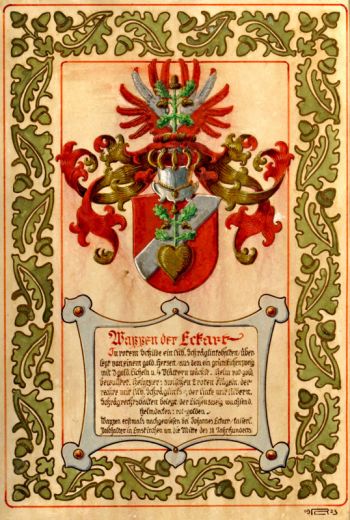Das Wappen der Familie Eckart/en: Unterschied zwischen den Versionen
Keine Bearbeitungszusammenfassung |
Keine Bearbeitungszusammenfassung |
||
| (5 dazwischenliegende Versionen desselben Benutzers werden nicht angezeigt) | |||
| Zeile 3: | Zeile 3: | ||
[[Datei:FA-FA92_3_Wappen_der_Familien_Eckart_und_Zick.jpg|350px|thumb|right]] | [[Datei:FA-FA92_3_Wappen_der_Familien_Eckart_und_Zick.jpg|350px|thumb|right]] | ||
The Eckart family’s coat of arms consists of a red escutcheon with a silver bend sinister on which a golden heart is superimposed. From it grows a green oak twig with three golden acorns and four green leaves. Above the escutcheon is a helmet with a red and golden torse. The helmet is placed between two red wings – the one on the right with a silver bend sinister, the one on the left with a silver bend (dexter) and, between them, the same oak twig as on the escutcheon.<ref>Eckart Family Archive, FA-FA92-3, coat of arms of the families Eckart and Zick.</ref> | |||
First evidence for the use of this coat of arms exists for the children of [[Johannes Eckart (V)/en|Johannes Eckart]] (1725 to 1790). It can be found, amongst others, on hymn books and as seal on [[Carl August Eckart (VI 18)/en|Carl August Eckart]]'s [[Testamente von Carl August Eckart/en|last will and testament]] from 1854. The coat of arms could date back to a certain Heinrich Erhard Eckart, who lived in the 17<sup>th</sup> century, but was not a direct relative of Johannes Eckart’s family branch.<ref>Eckart, Otto and Kamp, Michael: "Die Geschichte der Familie Eckart. Von Franken nach München und Hawaii" (The History of the Eckart Family. From Franconia to Munich and Hawaii), Munich 2015, page 104.</ref> | |||
== | == References == | ||
Aktuelle Version vom 23. August 2021, 18:22 Uhr
The Eckart family’s coat of arms consists of a red escutcheon with a silver bend sinister on which a golden heart is superimposed. From it grows a green oak twig with three golden acorns and four green leaves. Above the escutcheon is a helmet with a red and golden torse. The helmet is placed between two red wings – the one on the right with a silver bend sinister, the one on the left with a silver bend (dexter) and, between them, the same oak twig as on the escutcheon.[1]
First evidence for the use of this coat of arms exists for the children of Johannes Eckart (1725 to 1790). It can be found, amongst others, on hymn books and as seal on Carl August Eckart's last will and testament from 1854. The coat of arms could date back to a certain Heinrich Erhard Eckart, who lived in the 17th century, but was not a direct relative of Johannes Eckart’s family branch.[2]
